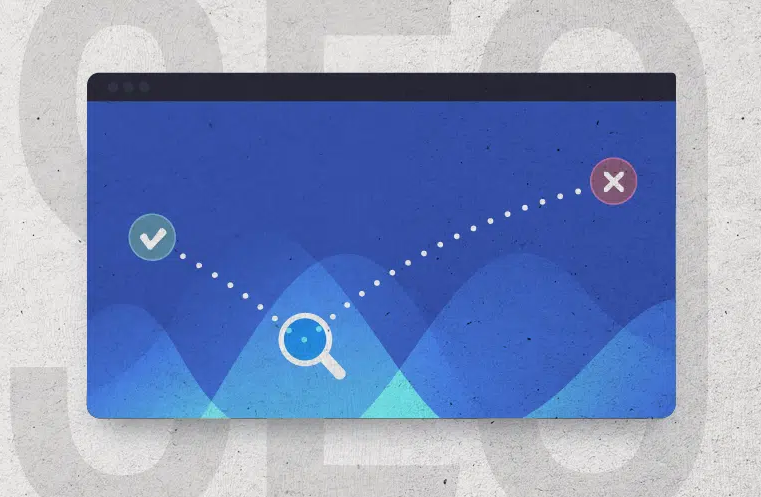In digital marketing, one of the key factors for gauging a website or page’s engagement and effectiveness is its overall bounce rate. This is the rate at which people land on a page and do nothing else before leaving. They don’t send any further requests to the server by completing actions on the page or moving to a new page. The session length counts as 0 in Google Analytics because it cannot be calculated. This is represented in Google Analytics as a percentage, or the number of bounce sessions divided by all sessions.
Because bounce rate is so deeply connected to the effectiveness of a business’s marketing efforts, the task of diagnosing bounce rate is crucial to increasing user engagement, improving site rankings, and ultimately, driving more revenue. In this article, we’ll provide deeper insight into why bounce rate is important, what causes it, and how you can reduce it to improve the effectiveness of your website in the long run.
Why Is Bounce Rate Important?
To start, let’s dive a bit deeper into what makes bounce rate so important. If the bounce rate for a page is low, this means that visitors are spending time on a page and exploring its content and links a bit further. They either interact with an element on the page or move to a new page within the website. On the flip side, a higher bounce rate indicates that visitors are leaving a page before going further, exiting before completing any actions.
A high bounce rate can sometimes indicate that there’s a problem with the user experience of a given website. For instance, it might indicate that the content on those pages is missing some relevance or confusing visitors, possibly needing some edits to better match user intent. Likewise, a higher bounce rate could that your visitors encountered a non-responsive page, triggering them to want to leave faster and seek their desired information elsewhere.
That being said, a higher bounce rate isn’t necessarily a bad thing. Context is key here, and the support folks at Google Analytics remind us that bounce rate concerns are relative to the structure of your website. If success on your website is determined by users visiting more than one page, like browsing product pages or making a purchase, then a higher bounce rate would definitely indicate a disconnect with user experience. Your team might even be dealing with frustrated customers or abandoned shopping carts if the disconnect was in your sales funnel. However, if you’re running a single-page website like a blog or offering other types of content for which a single page is all that’s required, then a higher bounce rate isn’t out of the ordinary. In fact, it’s perfectly normal. This applies to visitors simply needing quick information as well, such as office hours or contact information.
Can Google Cause a High Bounce Rate?
While most bounce rate discussions focus on what businesses should be doing to diagnose a high or low number, Google can actually play a role in a higher bounce rate as well. In general, Google’s algorithm does a pretty good job of identifying what a page’s content is about and how it can work to answer a user’s search query. Every once in a while, however, Google connects a user with a website that doesn’t really match what they were looking for. This typically happens when a person uses a poor choice of keywords, a rare search phrase, or is too vague in their search. Naturally, this is going to lead to a scenario where the user simply leaves the page unsatisfied, hoping to find their answer elsewhere. They didn’t find the content they needed. If this occurs often, it can mean that there is a mismatch between the intent of users searching and the content you’re serving them.
How Can I Reduce My Website’s Bounce Rate?
There are a lot of factors that go into reducing your website’s bounce rate, the bulk of which tie in with Google’s preference on designing your website for user experience. Here are a few of the most common and easy to implement:
1. Pay Attention to Page Speeds
Let’s face it, no one likes to sit around waiting for website pages to load. It affects our ability to quickly find information, our desire to explore a website further, and even our desire to revisit that same website later. In short, slow-loading pages are a hinder to user experience, and they can directly contribute to a higher bounce rate when users inevitably seek out alternatives.
Like any business, page speeds are something our agency takes very seriously. Our business depends on potential clients being able to quickly access information related to our services, whether that’s solutions related to SEO, web development and UX, link-building, or paid advertising. At the same time, if a potential client is on the fence about whether we’re the right fit, we want our case study and industry landing pages to load just as quickly, as these provide valuable information regarding our expertise across fashion digital marketing, health and wellness marketing, beauty and skincare, and more.
When we analyze our website data, we want that bounce number to be lower, as that indicates that visitors are sticking around our pages for longer and (hopefully) enjoying their journey through our website. They’re clicking through extra pages, engaging with our calls to action, and filling out our contact form or jotting down our phone number for a chat. In summary, when we see go through the process of updating our website, we pay very close attention to how these changes might be affecting our bounce rate.
2. Offer Easy Site Navigation
Like page speeds, the navigational structure of your website is also tied to user experience and, in turn, can offer solid insights into your bounce rate. Users naturally want an easy-to-navigate experience, and 94% of users base their first impression of a website on its design alone. Not only can a poorly designed website lose credibility points with your target audience, but it can hinder their ability to find information quickly. If you’re running an eCommerce store, a poorly designed site can also negatively affect the sales funnel, increasing the chance of abandoned shopping carts, negative reviews, or losing potential customers to a competitor.
While the steps to improve your site navigation might take some time, that time is well spent. Not only will your users thank you, but you’ll be building up credibility in the process, bolstering your chances of improving your organic search rankings.
3. Make Your Website Mobile-friendly
Google loves websites that are mobile-friendly, and their mobile-first indexing has been an ongoing effort for several years now. In fact, mobile devices (excluding tablets) are generating 54.4% global website traffic as of the fourth quarter of 2021. Put simply, it’s become the dominant way that people search Google for products, services, and information.
Mobile users have even less patience than desktop users. When they encounter an unresponsive page or website, they tend to click away that much faster, making it all the more necessary to make sure your website’s mobile experience is pristine. With mobile-friendliness being a confirmed ranking factor for Google, businesses looking to remain competitive in organic search rankings should already be doing everything they can to please this growing audience. By taking the necessary steps to do so, they can naturally lower their bounce rate in the process.
4. Clean Up Your Content
By default, website content should be clean and effectively formatted. It’s crucial from a user experience standpoint, and no site visitor wants to be attacked by giant blocks of disorganized text. They’re likely to leave before finding crucial information, attributing to a higher bounce rate for content you likely took special time to create. To get ahead of this problem, try to keep your information formatted into smaller blocks, complete with bullet points and relevant images and/or video. Not only does this make your content easier to digest, but it also makes it more sharable as well, a win-win by anyone’s standards.
5. Keep Your Keywords Relevant
While your website content needs to be relevant to your target audience, your chosen keywords need to be carefully researched and worked in as well, as they’re the lifeblood of solid SEO strategy and a vital part of communicating to Google what your pages are about. One of the hallmarks of creating quality content is making sure that it’s search-friendly. If the relevant audience has trouble finding it or if Google has trouble understanding your page, you’re already losing out on potential traffic and revenue. Therefore, to avoid any situations where keywords might negatively affect your bounce rate, make sure that you have a solid content strategy in place, one that includes working them into your pages’ titles, headings, internal link anchor text, title tags, and meta descriptions.
6. Avoid Popups or Distracting Ads
Just as most users hate to be inundated with huge blocks of text, they’re equally offended by large popups and distracting ads. They get in the way of great content, and they’re a major eyesore, especially on mobile. If you need to place ads on your website, try and stick to cleaner, less invasive types. Horizontal, rectangular ads at the top of your pages and ads within the content or along the sides will be generally more accepted.
7. Provide a Convincing Call to Action
Whether you’re looking for form fills, subscriptions, or purchases, your website should feature a prominent and convincing call to action. After all, your goal as a business is to help others to see the value in your page’s offers or products, so it only makes sense that users should be able to locate this CTA within seconds of being on a page.
How do you accomplish this? It’s easy. Keep your language simple and specific. That means avoiding any fancy or complicated jargon that might confuse users on their way through the conversion process. Make each CTA specific to your goal, whether it’s a newsletter subscription or digital course signup.
8. Work with the Digital Marketing and Web Development Experts at VELOX Media
At the end of the day, reducing the bounce rate of your website involves a lot of moving parts which, if implemented correctly, can significantly improve the user experience of your website in the process. If you’re looking to increase user engagement, generate more qualified leads, and improve the performance of your SEO campaigns, the digital marketing experts at VELOX Media can help.
As a Google Premier Partner with over 10 years of experience in SEO, UX, content marketing, and paid advertising, we have the tools necessary to help our clients optimize their websites for better conversions and organic search rankings. Reach out to VELOX Media to learn how we can help improve your SEO and website strategies today.
About the author:
VELOX Media is an award-winning, ROI-focused digital marketing agency that specializes in strategy, organic search marketing optimization, paid management, and web development. We specifically target a 400%-800% monthly ROI above spend and are ranked among the top 3% of agencies in the world by Google.





